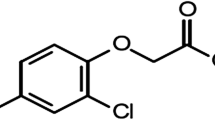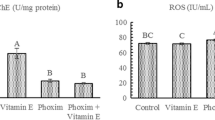Abstract
Methomyl carbamate is a pesticide widely used in the control of insects. The present work aims at studying the effect of selenium on the antioxidant system of methomyl-treated mice. Swiss albino mice were intraperitoneally administered a single dose of methomyl (7 mg/Kg body weight). Mice of another group were injected with sodium selenite (5 μmole/Kg b.wt.) 7 days before methomyl intoxication. After 24 hours, methomyl exposure resulted in significant increase in lactic dehydrogenase activity (LDH). The antioxidant capacity of hepatic cells in terms of the activities of superoxide dismutase (SOD), catalase (CAT), glutathione reductase (GR), glutathione-S-transferase (GST) and glutathione (GSH) content was diminished. It appears that methomyl exerts its toxic effect via peroxidative damage to hepatic, renal and splenic cell membranes. Also, methomyl induced DNA damage in these organs as detected by alkaline filter elution technique. The distribution of methomyl in different organs of mice was detected by HPLC. Selenium administration prior to methomyl injection produced pronounced protective action against methomyl effects. It is observed that selenium enhances the endogenous antioxidant capacity of the cells by increasing the activities of SOD, CAT, GR and GST as well as increasing GSH content. The activity of LDH was decreased in blood and the damage of DNA was suppressed comparable to controls. In conclusion, the adverse effects of methomyl in mice could be ameliorated by selenium.
Resumen
El carbamato metomil es un pesticida ampliamente utilizado en el control de insectos. Se estudia en el presente trabajo el efecto del selenio sobre los procesos antioxidantes en ratones tratados con metomil. A ratones albinos Swiss se les inyectó una dosis única por vía intraperitoneal de metomil (7 mg/Kg peso corporal) y a un grupo de ellos se les había inyectado 7 días antes selenito sódico (5 micromoles/Kg p.c.). La administración de metomil produce, tras 24 horas, aumento de la actividad láctico deshidrogenase (LDH) y disminución de la capacidad antioxidante en células hepáticas, estimada por las actividades superóxido dismutasa (SOD), catalasa (CAT), glutation reductasa (GR) y glutation-S-transferasa (GST) y por el contenido en glutation (GSH). Esto parece indicar que la toxicidad del metomil se relaciona con daño peroxidativo en las membranas de las células esplénicas, renales y hepáticas. Además, tambien se observan en esos órganos alteraciones en el DNA. La administración previa de selenio protege de los efectos del metomil. El selenio aumenta la capacidad antioxidativa endógena celular por incremento de las actividades SOD, CAT, GR y GST asi como del contenido en GSH. La actividad LDH en sangre disminuye, asi como el daño en el DNA, hasta valores comparables a los controles. En suma, el selenio protege de los efectos adversos del metomil en el ratón.
Similar content being viewed by others
References
Abdollahi, M., Rahmat-Jirdeh, N. and Soltaninejad, K. (2001):Hum. and Exper. Toxicol.,20, 28–33.
Abdollahi, M., Ranjbar, A., Shadnia, S. and Nikfar, S. (2004):Med. Sci. Monit. 10, RA141–147.
Aebi, H. (1984): “Catalase. In: Methods in enzymatic analysis”, Vol. 3, Bergmeyer, HU. Eds. Academic Press, New York.
Aron, C. K. and Howland, M. A. (1998): “Insecticides: Organophosphates and carbamates In: Goldfank Toxicology Emergencies”, 6th ed, Appleton and Lange, New York, London, Sydney, Toronto, Tokyo, New Jersey.
Banerjee, B. D., Seth, V. and Bhattacharya, A. (1999):Toxicol. Lett.,107, 33.
Beckett, G. J. and Arthur, J. R. (2005):J. Endocrinol.,184, 455–465.
Beutler, E. (1982): “Red cell metabolism. A manual of biochemical methods” Grune and Stratton, New York.
Cesarone, C. F., Bolognesi, C. and Santi, L. (1979):Ann. Biochem.,100, 188–197.
Habig, W. H., Pabst, M. J. and Jakoby W. B. (1974):J. Biol. Chem.,249, 7130–7139.
Hazarika, A., Sarkar, S. N. and Kataria, M. (2001):Indian J Exp. Biol.,39, 1113.
Horn, H. D. (1971): “Glutathione reductase. In: Methods of enzymatic analysis” Bergmeyer HU, ed., Academic Press, New York.
Hulla, J. E., Miller, M. S. and Taglor, J. A. (1999):Toxicol. Sci.,51, 317.
Kahler, W., Kuklinski, B., Ruhlmann, C. and Plotz, C. (1993):Z. Cesamte. Inn. Med.,18, 223–232.
Lohinay, O. and Sinhaseni, P. (1998):Arh. Hig. Rada. Toksikol.,49, 231–238.
Lowry, O., Rosebrough, N., Fare, A. and Randall, R. (1951):Int. J. Tiss. React. 4, 153–139.
Moss, D. W., Hendersen, A. R. and Kachmar, J. R. (1986): In: Textbook of clinical chemistry”. Tietz NW. ed. Philadelphia, PA: WB Saunders.
Nishikimi, M., Rao, N. and Yagi, K. (1972):Biochem. Biophys. Res. Commun.,46, 844–853.
Pajoumand, A., Jalali, N., Abdollahi, M. and Shadnia, S. (2002):J. Pharm. Pract. Res.,32, 297–299.
Pree, D. J., Whitty, K. J., Bittner, L. A. and Pogoda, M. K. (2003):Pest. Manag. Sci.,59, 79–84.
Ranjbar, A., Pasalar, P. and Abdollahi, M. (2002):Hum. Exp. Toxico.,21, 179–82.
Sargent, E. V., Sina, J. F. and Barnum, J. E. (1999):Drug Chem. Toxicol.,22: 583.
Shen, H. M., Shi, C. Y., Lee, H. P. and Ong, C. N. (1991):Toxicol. Appl. Pharmacol.,127, 145–150.
Shou, J., Osman, A. F. and Multani, A. S. (2002):Oncogen.,21, 878.
Suramana, T., Sindhuphak, R. and Dusitsin, N. (2001):Sci. Total Environ.,270, 103.
Thapar, A., Sandhir, R. and Kiran, R. (2002):Indian J Ezp Biol.,40, 963–966.
Tsai, M. J., Wu, S. N., Cheng, H. A., Wang, S. H. and Chiang, H. T. (2003):J. Toxicol. Clin. Toxicol.,41, 969–973.
Tsatsakis, A. M., Tutudaki, M. I. and Tzatzarakis, M. N. (1998):Vet. Hum. Toxicol.,40, 200.
Whanger, P. D. (2001):Nutr Neurosci.,4: 81–97.
WHO.Environmental Health Criteria, 1996:178, 29.
Zeljezic, D. and Garaj-Vrhovac, V. (2001):Mutag.,16, 359.
Author information
Authors and Affiliations
Corresponding author
Rights and permissions
About this article
Cite this article
El-Khawaga, A.Y. Role of selenium on antioxidant capacity in methomyl-treated mice. J. Physiol. Biochem. 61, 501 (2005). https://doi.org/10.1007/BF03168375
Received:
DOI: https://doi.org/10.1007/BF03168375




